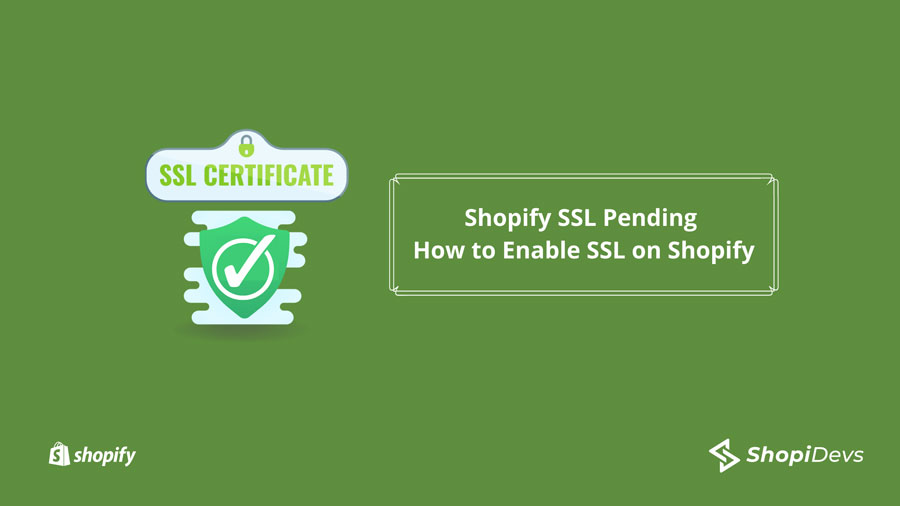2220 cyber-attacks occur every single day, which means one attack in just 38.91 seconds. Not having an SSL certificate or Shopify SSL pending is one of the weakest zones and risk factors for your store’s security.
You need to update DNS, and CNAME, then remove IPv6 and CAA Records, then verify domain ownership. Now wait for 48 hours for DNS propagation, if still it isn’t activated, clear your browser cache.
Let’s explore the step-by-step guide on how to enable an SSL certificate on Shopify and secure your store!
What is SSL?
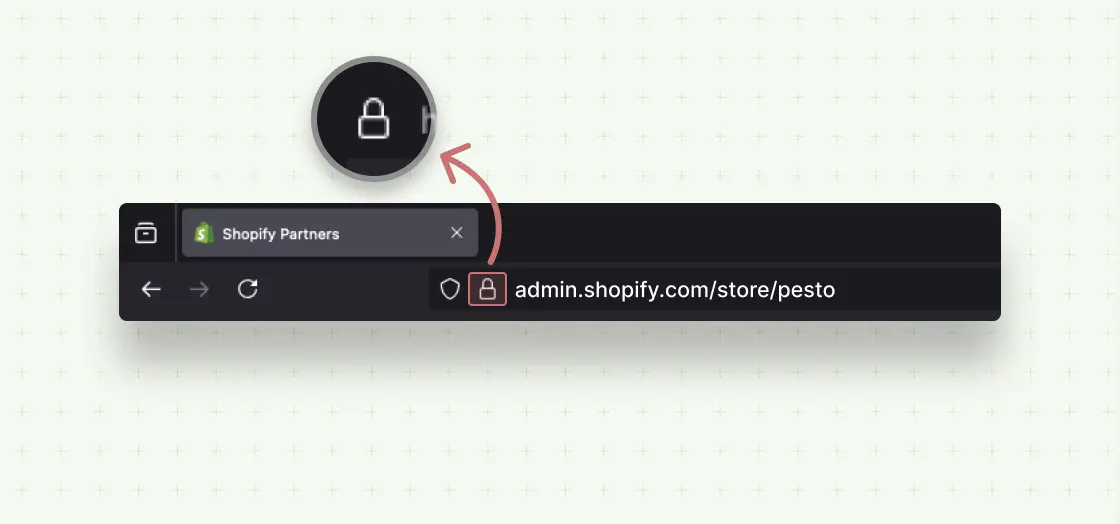
SSL (Secure Sockets Layer) is a technology that forms a secure link between the data server and the users’ browsers. It prevents the threat of data being stolen by unauthorized third parties. SSL is useful to protect your store from data breaches and thefts by hackers.
If you have enabled an SSL certificate on your website, it will show HTTPS before the domain name and only HTTP without an SSL. When your site has an SSL certificate, your content and information are safe with HTTPS. All the users’ activities on your site become encrypted, which means their data becomes risk-free
5 Reasons Why SSL is Important for Shopify Store
There are a lot of benefits to using an SSL certificate (https) on your Shopify e-commerce store. Here are 5 reasons why you should have the SSL on the Shopify store:
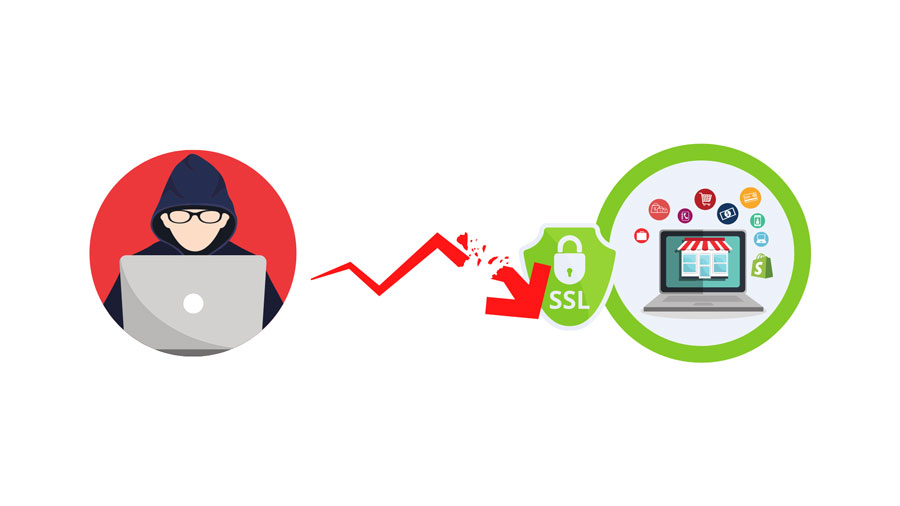
- Secure Customer Data: SSL encrypts sensitive information like credit card numbers and addresses. It protects your customers’ privacy from intercepting hackers and keeps customers safe shopping on your site.
- Builds Customer Trust: A padlock icon in the browser shows visitors that the site is secure. This visual assurance boosts trust, encouraging customers to complete their purchases.
- Boosts SEO Performance: Google ranks secure websites higher than non-secure ones. SSL helps improve your Shopify store’s visibility, driving more organic traffic to your site.
- Improved Website Performance: SSL can speed up your website’s loading time. Which is helpful for SEO and provides a better user experience and potentially higher conversion rates.
- Prevents “Not Secure” Browser Warnings: Without SSL, browsers like Chrome display “Not Secure” warnings to visitors. It can discourage them from staying on the site. So an active SSL certificate removes these warnings, which gives a seamless experience.
These are the most important reasons why the SSL certificate is so important. But when you try to activate the SSL on Shopify, it may show ‘SSL pending’. Let’s learn about this term and fix this issue.
What is SSL Pending Shopify Meaning?
Until the SSL certificate is fully active, visitors may not see the padlock icon in the browser. When you have an “SSL Pending” message under the domain settings, that means it has not been activated yet.
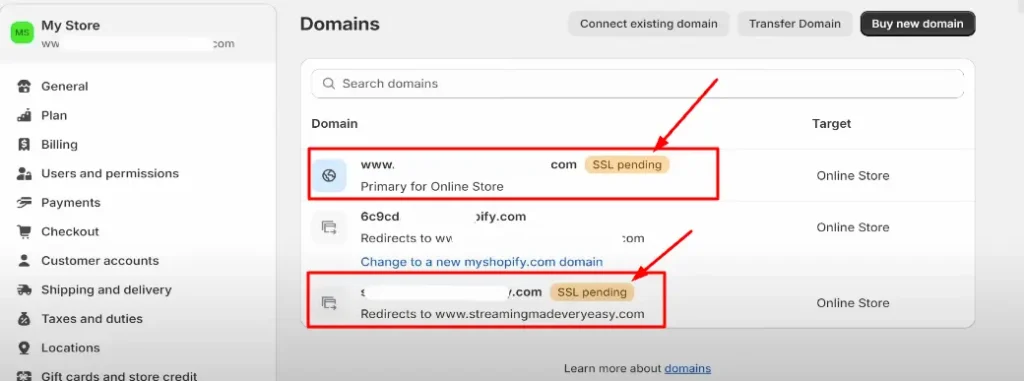
Here, we will talk about two different parts of this error message:
What is SSL Pending on Shopify?
SSL Pending on Shopify is a temporary state while the system verifies your domain and sets up a secure connection. This indicates that your store’s SSL certificate is in the process of being issued and installed.
What Does SSL Pending Mean on Shopify?
The Shopify SSL pending means that your Shopify store has no active SSL certificate yet, but it is under processing. That’s why Shopify shows an error message when it generates your website certificate. During this stage, you should be aware that your site is not protected against the threats of online hackers.
Remember, although your site is not secured, it is still published, and anyone can access it. As an eCommerce store owner, you should not keep using your store without fixing the issue “Shopify SSL Pending.” Otherwise, you may face security threats in your store, and that may cause a great loss for your business.
Common Causes of Shopify SSL Pending
Though it is very common to have “SSL pending” issues while trying to make a live Shopify store, it might happen for different causes. Let’s check a few common culprits behind this error:
- Incorrect DNS Settings: Incorrect ‘A records’ or ‘CNAMEs’ can prevent Shopify from accessing your domain.
- DNS Propagation Delay: Changes to DNS settings can take up to 48 hours to propagate globally.
- New Domain Added: Shopify needs time to verify and issue an SSL certificate for newly added domains.
- Multiple Domains Linked: Sometimes, complex domain configurations with multiple Shopify stores with various domains can lead to SSL pending issues.
- Shopify System Delays: Temporary technical issues or high server load can delay the SSL activation process.
- Browser Cache Issues: An outdated browser cache can display incorrect SSL status (Previously loaded data), even if it has already been activated.
If you encounter SSL Pending, it’s usually best to wait for a few hours. If the issue persists, you can contact Shopify’s support team for further assistance.
How to Fix SSL Pending On Shopify in 5 Easy Steps
As the SSL certificate pending issue might occur for different causes, the solution also may be different based on the issue. Before launching the store, let’s try to fix the issues by checking all possible things in just 5 steps:
1. Check and Fix (Update) DNS Records
If you get a domain from Shopify, you may not face any SSL issues as Shopify usually does everything for you. When you add a third-party domain in Shopify, then you have these issues.
So, you need to check the DNS records of your domain whether it is pointed at the Shopify IP address or not. If it doesn’t match, then delete the previous A record and TXT file and update all records for Shopify on your domain register dashboard:
- A record: Point it to 23.227.38.65.
- CNAME: For “www”, set it to shops.myshopify.com.
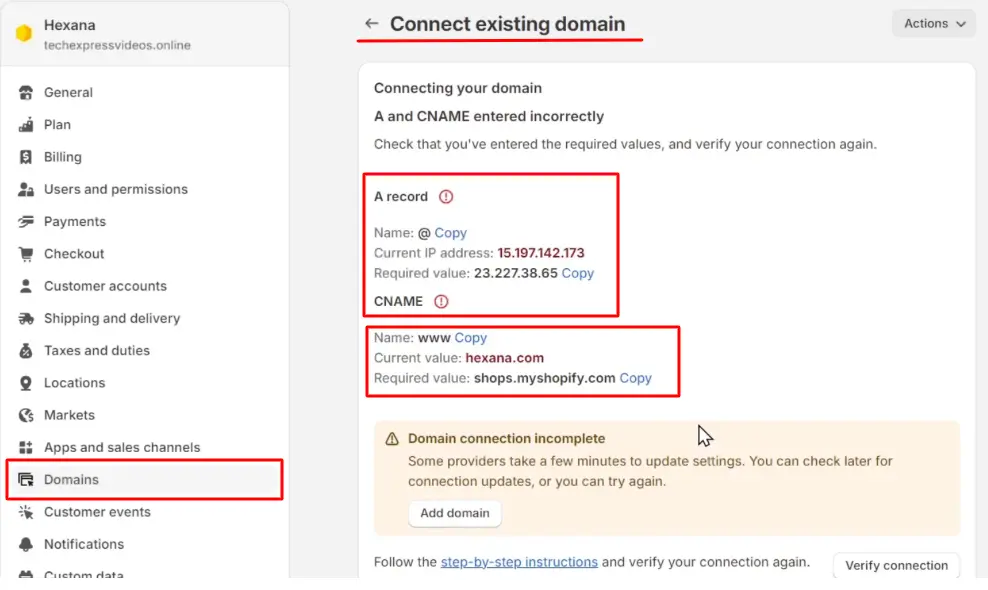
Incorrect DNS settings are the most common reason for SSL pending issues. You need to ensure your DNS records are configured correctly.
Remove IPv6 and CAA Records
Importantly, you should know that you cannot use multiple A records for a single domain. If you do so, you will get the SSL unavailable error in Shopify.
Shopify does not allow IPv6 (AAAA) records although it is a valid A record type. Using this type of record may result in errors in HTTPS encryption on your Shopify site. Instead of IPv6, you should use IPv4 A records to ensure the security of your business.
Using CAA records seems like an additional step that you can remove. Having this may create an issue regarding HTTPS encryption in Shopify.
2. Verify Domain Ownership
If you have added a new domain recently, then Shopify might need to verify your ownership before activating the SSL. Then cooperate with Shopify’s verification process to activate the SSL certificate.
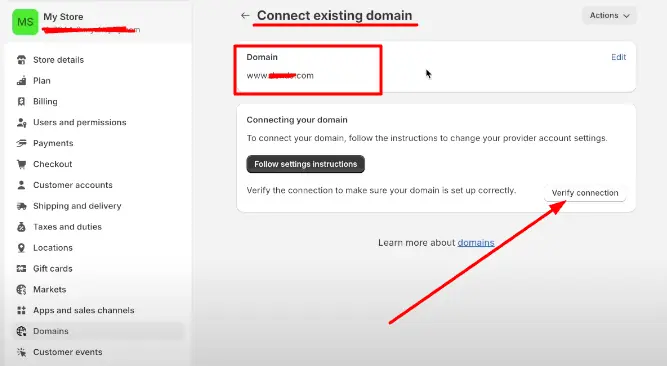
Also, ensure your domain is listed correctly under Online Store > Domains in Shopify. And you have to set the domain type as the “primary domain” for your online store. So, Shopify prioritizes the domain to provide the SSL quickly.
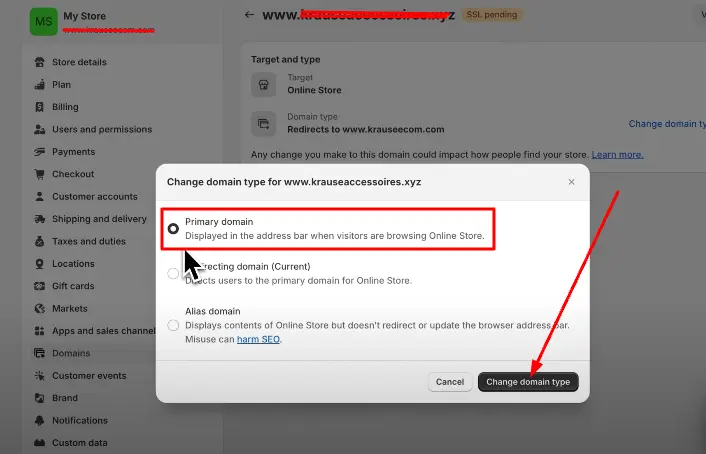
3. Wait for 48 Hours for DNS Propagation
When you see the SSL pending or an error message, it is not always your problem. Shopify takes 24-48 hours to verify your ownership and authentication to provide the SSL certificate (HTTPS). In some cases, it might take 72 hours, the certificate will be verified or renewed during this time. After verification is done, it starts HTTPS encryption on your website. If it does not activate after 48 hours, you need to take action as security is a vital part of an online store.
4. Clear Browser Cache and Cookies
Have you set everything perfectly, and given enough time to Shopify for verifying, but still it is not responding? Shopify might have activated the SSL certificate, but you are not getting the update status.
Yes, sometimes it can happen for outdated browser caches and cookies data. So, clear your caches and cookies from the browser settings, then check the SSL pending status on ‘incognito’ mode. Also, you can check the pending status from another device to rule out browser-specific issues.
How To Delete Caches and Cookies Data on Chrome Browser
- Step 1: Open the Chrome browser.
- Step 2: Click on the 3 dot menu from the right side-upper corner.
- Step 3: Go to “More tools” and “Clear browsing data” for Windows (“Delete browsing data” for Mac).
- Step 4: Choose the time range “All Time”, and checkmark all data.
- Step 5: Confirm “delete data” from your browser to have a fresh browser without caches or cookies.
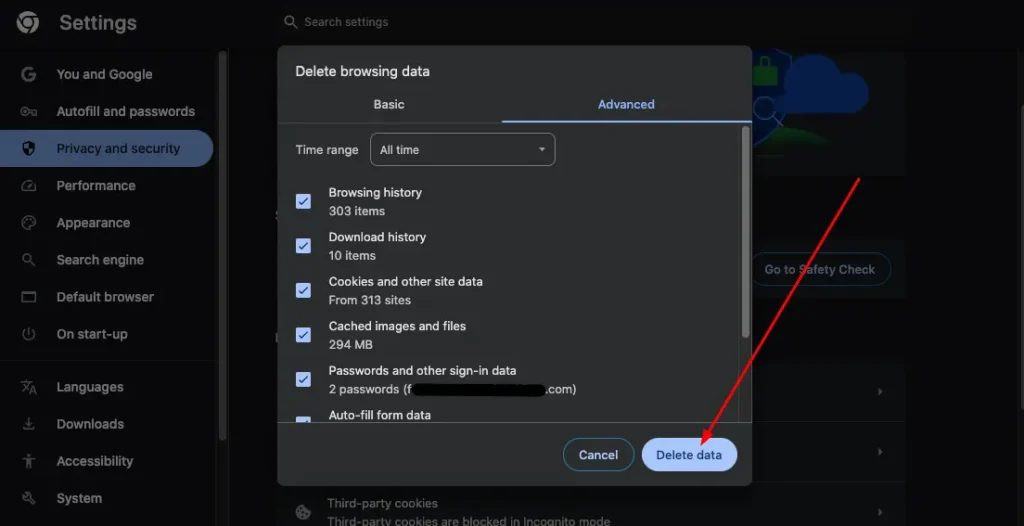
5. Contact Shopify Support
You have checked all DNS settings like A record, CNAME, TXT files, and other server-related settings. If the “SSL pending” issue persists beyond 48 hours, there might be a server-side problem or configuration issue on Shopify’s end.
So, visit the Shopify Help Center and contact their support team. They can ask to provide the necessary information to fix the issue. Also, Be prepared to cooperate with Shopify’s troubleshooting steps to resolve the issue promptly.
How to Check for SSL Pending Status on Shopify
There are two different ways to check for the SSL pending status on your Shopify store.
1. Through Your Shopify Admin Panel:

- Step 1: Log in to your Shopify admin panel.
- Step 2: Go to Settings > Domains.
- Step 3: Locate the domain you want to check.
If the SSL certificate is pending, you’ll see the status “SSL Pending” next to the domain name.
2. By Visiting Your Store from a Browser
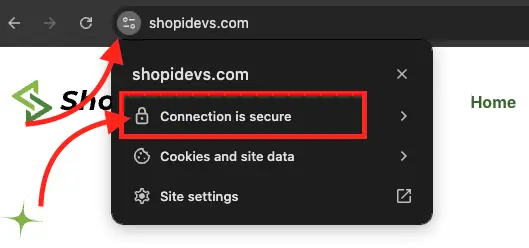
- Step 1: Open your Shopify store in a web browser.
- Step 2: Look for the padlock symbol in the address bar to the left of the URL and HTTPS.
But if the SSL certificate hasn’t connected properly, then you may see a warning message instead of the padlock.
Conclusion
Many store owners and developers face the common issue of “Shopify SSL pending ” while trying to add a custom domain. It may seem frightening for a Shopify beginner but it can be solved easily just by following the steps I have shared in the article.
In this complete blog post, you have learned about what is SSL, why it is important on Shopify, what it means, and how to fix the SSL pending error on Shopify. This 5 steps simple guide can be very helpful for you to secure your domain on Shopify.
When you buy a domain from Shopify, then Shopify can easily detect everything and provide the SSL quickly. But when you are adding a custom domain from other platforms like Namecheap, GoDaddy, etc., then it requires a bit of technical setting.
I hope you can easily solve the SSL pending issue without any hassle by following the guide with screenshots. After enabling the SSL certificate, you can easily make your store attractive by using the modern theme ‘Pesto’ from Shopidevs.
FAQs
Why is SSL Important for E-commerce?
SSL (Secure Sockets Layer) is crucial for e-commerce because it ensures customer data. It encrypts and protects their payment information and other sensitive data from hackers. SSL also builds trust with e-commerce customers, as they can see the secure “https://” in the URL. Additionally, it can boost SEO rankings, which can drive more traffic to your store.
How Long Does “Shopify SSL Pending” Take?
Generally, the SSL pending status on Shopify might take around 24-48 hours. But this process can take more time in a few rare cases. The duration of SSL certificate activation time can vary based on the verification method you choose. So, do not panic regarding the issue.
Why is My SSL Certificate Still Pending?
An SSL certificate might still be pending for several reasons:
- Incorrect DNS Settings: If DNS records (like A or CNAME) are not properly set, the SSL cannot activate.
- Propagation Delays: DNS updates can take up to 48 hours to complete, keeping SSL in pending status.
- Domain Verification Issues: Shopify may need additional time to verify domain ownership.
- Multiple Domains or Subdomains: More complex setups can take longer for SSL to activate.
If the SSL is still pending after 48 hours, it’s best to double-check DNS settings or contact Shopify support for assistance.
Jakaria is an SEO Content Writer in Shopify, Ecommerce, WordPress, and Tech Industry with 4+ years of experience. He specialises in developing engaging, helpful content by simplifying complex topics into an amazing story for B2B, SaaS, and Shopify businesses. He’s also passionate about staying updated on SEO strategies and Shopify trends.
